Last updated on 12/08/2017
This is the Dec 7 committee meetings. Dec 8th board meeting is above.
Update: I’ll fix these links and add some live-blogging during the meetings today and tomorrow.
They scheduled their last meeting during summer break, to coincide with a Duck football game. So I suppose this is a D+ if we grade them on improvement. Their website is hard to navigate, so here are the links and some additional info. All meetings will be in the Ford Alumni Center, Giustina Ballroom.
Dec 7th, 9AM. Academic and Student Affairs Committee — [Materials] [Webcast]
Mary Wilcox, Chair, Connie Ballmer, Rudy Chapa, Ann Curry, Allyn Ford, William Paustian, Michael Schill
This starts of with usual pablum about 24/7 academic excellence. At least the Board has stopped using the Ducks as an example of how us faculty and staff can achieve it.
1. Core Education Evaluation and Redesign: Scott Pratt, Executive Vice Provost; Chris Sinclair, President, University Senate; Sarah Nutter, Dean, Lundquist College of Business
I’m a little unclear on what the learning objectives are for this section. Maybe there will be some iclicker questions for the board at the end, to check comprehension.
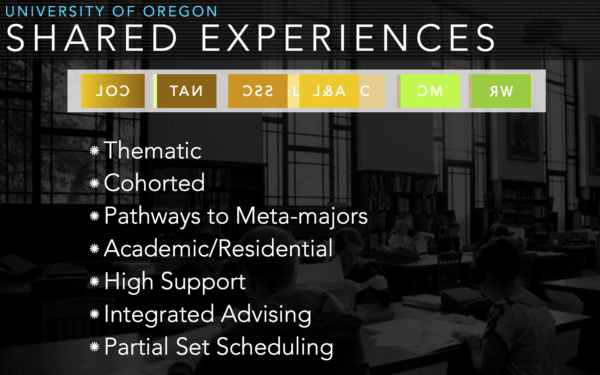
VPAA Scott Pratt starts of by explaining the current system, and noting that while it looks simple in theory, it’s been exploded by UO’s responsibility centered budget model. Two years ago it would have been heresy for an administrator to admit this. Now it’s dogma, and the RCM is being replaced by top-down control from the provost’s office. 10 years from now, …
Senate Pres Chris Sinclair lays out one possible proposal for Gen-Ed reform. Hope is to have a more structured first-year program, with students taking set of courses in related subjects, while living in dorms with other students interested in the same matters. Helps with retention, so on. Some changes to how we organize the multicultural requirement, since the buzzwords have changed – “tolerance” is out, for example.
LCB Dean Sarah Nutter: As working on expanding business ARCs. Goal is employment ready, globally connected graduates.
[I’m no Economics professor, but economics majors do better at this than business majors – according to the WSJ. Mid career salaries for econ majors average $98,600, while for business management majors it’s just $72,100. Parents should understand this before pushing their kids into a narrowly based vocational business program.]
Board Chair Chuck Lillis asks how we know students are learning something in writing classes. Notes that some universities keep a record of all student papers, and compare progression over their education. This is the best idea I’ve ever heard from him.
Connie Ballmer asks about the timeline, notes it’s an ambitious project. Who is in charge – Provost or Senate. Pratt and Sinclair: We both are. Her follow up is on metrics. Sinclair: Task Force. Ginevra Ralph asks about sexual assault training, which students talked about last year. Also asks Senate to make sure the requirements are flexible enough for non-traditional students. Ann Curry applauds fact program is flexible, provides a liberal education.
2. Online and Hybrid Education Planning: Scott Pratt, Executive Vice Provost; Adriene Lim, Dean, UO Libraries; Jessie Minton, Chief Information Officer
I’ve been listening to UO administrators talk about doing something online since Jim Bean. This ship has sailed. Pratt notes that while Bean bloviated, OSU acted, and now dominates online in the state. Now it’s going to be tough for UO to do more than fill in some gaps. Good reasons to build some more on-line anyway, even if only for our own students. So we’re going to throw some money and time at this. Step one will be to hire a Vice Provost, to hire some Assistant Vice Provosts.
The trustees are slowing realizing that UO is never going to make money at this, but we will help our students graduate more quickly.
3. Presidential Initiative in Data Science: Bill Cresko, Professor of Biology, Assoc. Vice President of Research, and Director of the Presidential Initiative in Data Science
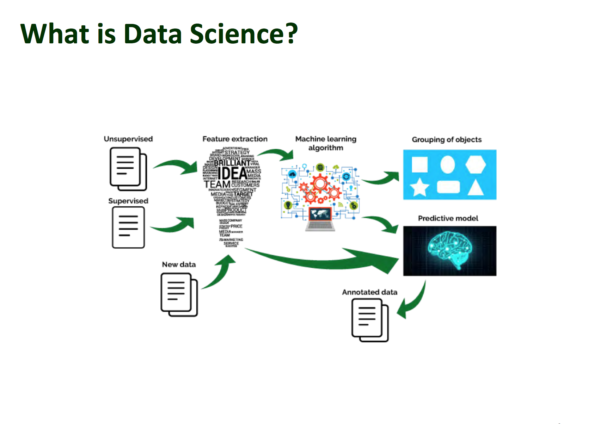
4. Annual Student Scholarship and Financial Aid Report: Jim Brooks, Associate Vice President and Director, Financial Aid and Scholarships
Normally the trustees would hear from VP for Enrollment Roger Thompson. But the enrollment news is embarrassingly bad, and no one wants to talk about it:
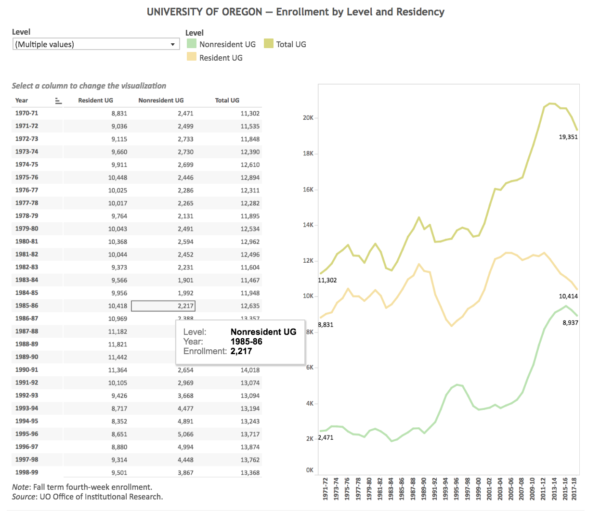
So instead we’ve got Jim Brooks. He does a good job presenting some informative slides:
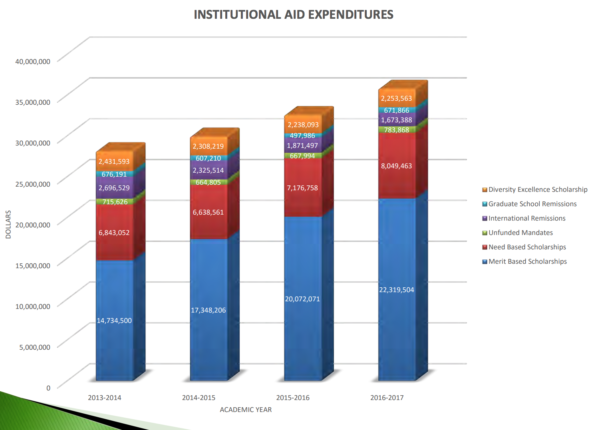
Most of UO’s aid is merit, not need based. and the growth rate for merit aid is far higher. (Some wiggle room in the categories though.) This is despite the growth of Pathway Oregon. As I’ve reported before, UO is failing when it comes to economic diversity, and the figure above shows why. Here’s more from IR:
Undergrad minority enrollment has nearly doubled since 2005 to 27%, but the percentage of low-income Pell grant eligible students peaked at 26% in 2011, and has fallen slightly since.
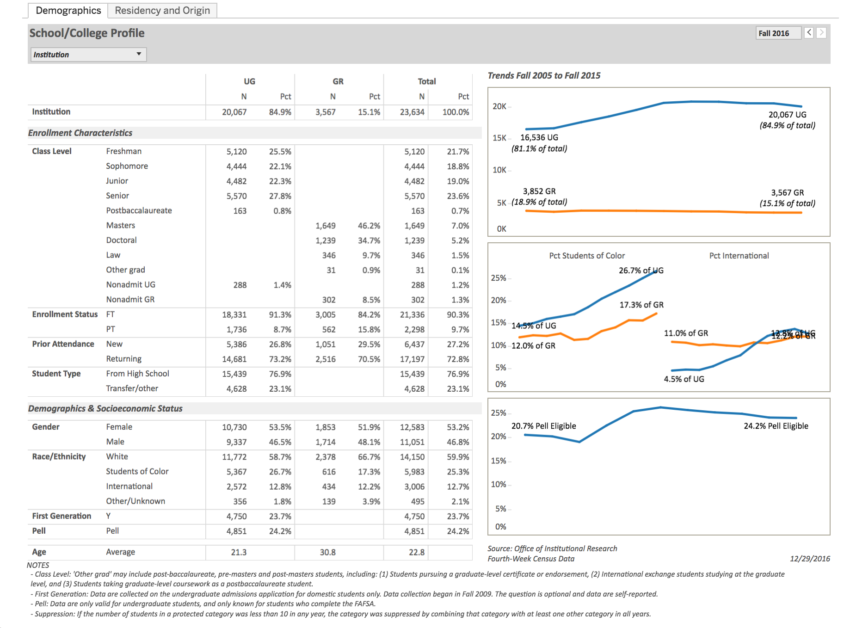
Here’s much more on this, based on NYT reports etc:
8/7/2017: UO is failing on economic diversity. Where’s the “Economic Diversity Action Plan”?
UO is ranked #328 out of 377 selective public colleges for promoting income mobility. 56% of our students come from families in the top 20% of the income distribution (4.3% from the top 1%) and only 4.7% come from the bottom 20%:
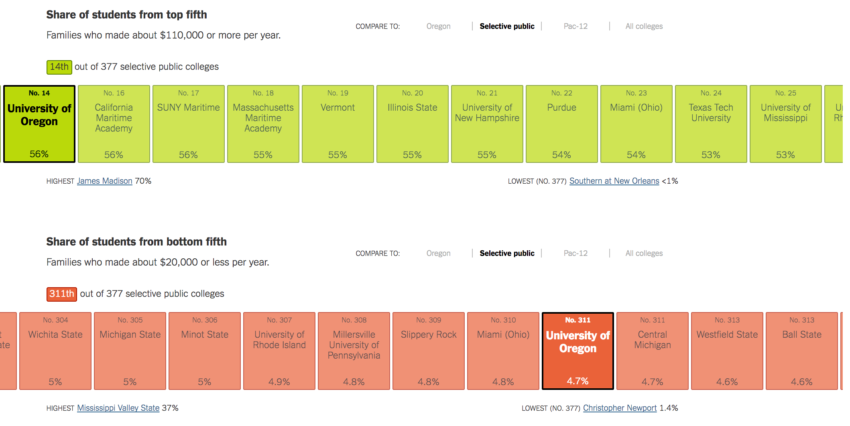
Brooks also reports that federal law will mean a $3.2M reduction in federal aid for UO students. Trustees ask some questions, this isn’t as drastic as it sounds.
Dec 7th, 10:45 AM, Executive and Audit Committee — [Materials Now updated with full Nike deal.] [Webcast]
1. Status of Information Technology at the UO: Jessie Minton, Chief Information Officer
2. Quarterly Audit Report: Trisha Burnett, Chief Auditor
The Audit Report will not be provided until the meeting, because we wouldn’t want the Trustees to have time to do their due diligence.
The Audit Report – such as it is – is now posted. There’s no meat here:
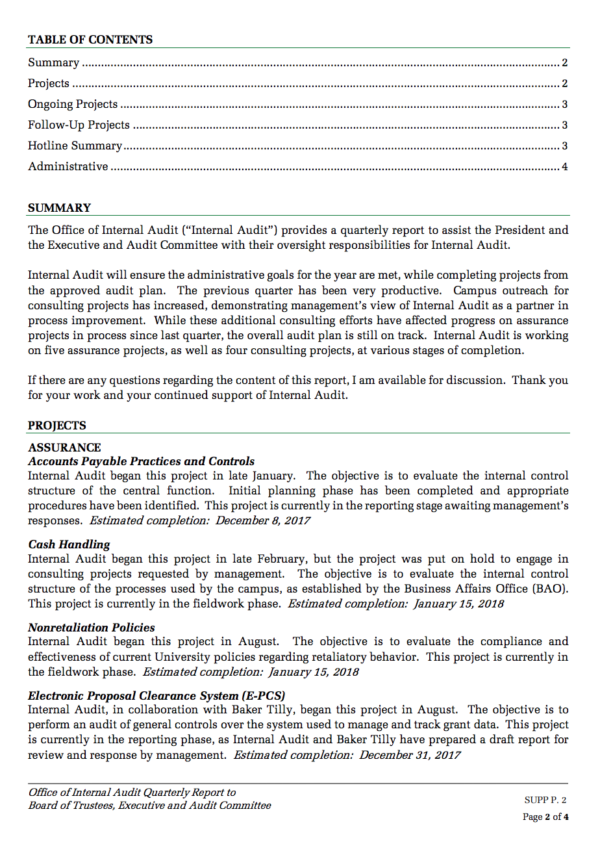
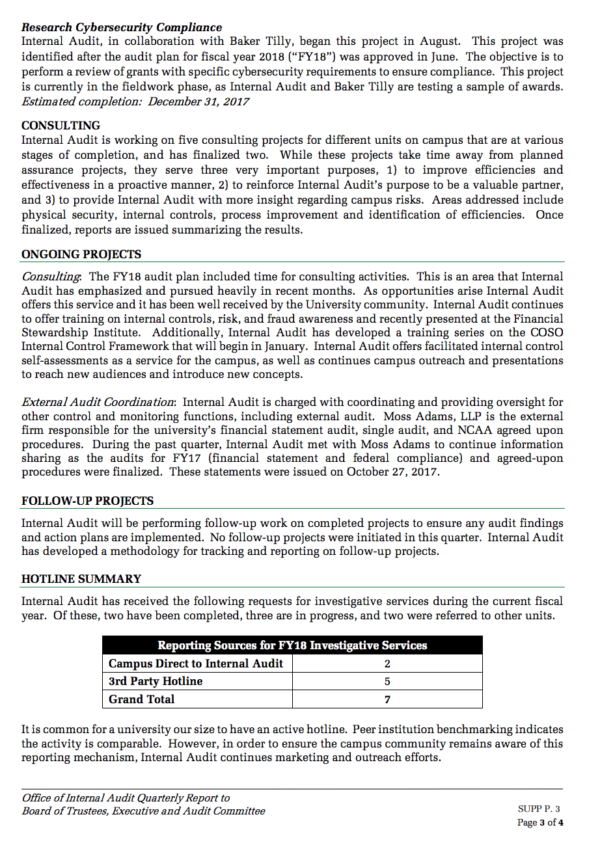

Say, I wonder what happened to the results from their audit of the athletic department? Whatever’s going on with UO Audits, the Trustees are never going to learn about it. Unbelievable.
Dec 7th, 1:30 PM, Finance and Facilities Committee — [Materials] [Webcast]
1. Annual Audited Financial Statements:
Pretty bare-bones data:
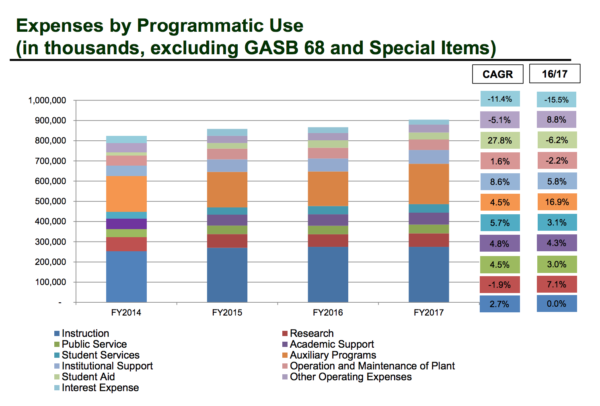
No substantive questions from the trustees as might be expected given that there is so little detail presented. Still no breakout of the athletic department budget – the $13.7M to buyout Helfrich is hidden in here somewhere, as is the millions in subsidies from the academic side.
Bond rating is good.
The external auditor presents UO with a “clean audit letter”, gets gushy about how great UO’s team is. Gosh, it’s almost like he wants to keep the UO contract.
Chuck Lillis – a man who has some experience with inadequate external audits and lawsuits against Board members – rather pointedly asks him if there is a rule requiring UO to switch auditors every few years – as is true for publicly traded corporations. Turns out there’s not. Nor does Moss Adams have an internal rule requiring that their employees rotate – to avoid too much coziness with the clients.
2. Quarterly Financial Reports: Jamie Moffitt.
As is true every year, Moffitt tells the board we are “run rate even” – despite drop in tuition revenue, international students, increase in pension costs, etc. More state revenue, more grants, etc.
JP at IR keep promising the employment numbers below will be updated, and there’s nothing about this in Moffitt’s report, but here’s where the money has been going. On a Full Time Equivalent basis, faculty numbers are up 22%, since 2007-8, while administrator numbers are up 43%:
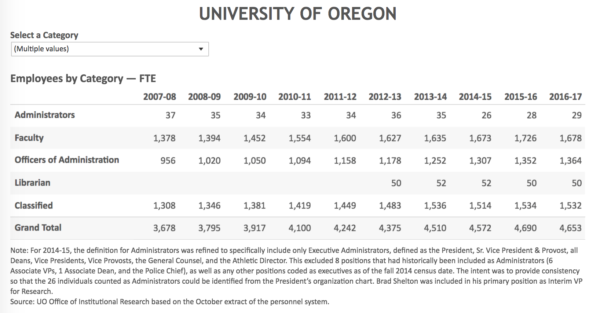
3. Intercollegiate Athletics Multi-Sport Apparel Agreement (Action):
See post here.
4. Capital Planning Annual Report:
5: Tykeson Hall – Capital Project Reauthorization (Action):
The PLC faculty are going to die there and rot in its ruins. Meanwhile they’ve added another floor to the new Tykeson building – but not for faculty.
3:10PM. That’s it for today. See you tomorrow:
I’ll be there.
It’s at 8 AM dude. I’m going to bail if there’s any more damn chanting.
Well I wasn’t planning on doing that.
Like ;)
Lot’s of interesting stuff there in that budget graph (Audit Financial). But does anyone know what CAGR means? I assume 16/17 refers to the change from the previous year. In any case, however you slice it, some of the numbers look pretty damning. But I await with hope some clarification before I delve into this.
Compounded Annual Growth Rate? Just guessing, I’m an economist, not a CPA.
Ah, very good, sounds right. A measure of change over multiple years.
The numbers very revealing. “Instruction” — the budgets for the departments, basically — very low rate of growth. Lots of other stuff growing much faster. Student services, “Institutional Support” — aka central administration. No wonder they gotta get rid of those adjuncts. “Auxiliaries” growing very rapidly — that’s mainly dorms and sports. Shows what somebody’s priorities are.
uomatters — you say “On a Full Time Equivalent basis, faculty numbers are up 22%, since 2014-15, while administrator numbers are up 43%” —
surely this is not correct from the data — do you mean “since 2007-08”?
In any case, the numbers are very revealing, almost begging for scathing criticism. Is there any reclassification that might be involved in the exploding “administrative” staff?
Probably the most salient data now would concern the changes since Schill came in. If the previous administrators/chaos agents — the long-ensconced Dave, then the time of the revolving door guys — were parodies of adminstrative bloaters — has it at least stopped under Schill?
In the latest year given — 16-17 — Officers of Administration continued to creep up — while faculty took a sizable hit.
Is the AAU watching? How about the accreditors? Our hapless Legislators and Governor, God bless them?
Or if 16-17 is perhaps an anomaly — I can go back to just about any year in the series, and come to the same conclusion — OA bloat, faculty/academic starvation.
Whoops, fixed. Thanks.
Re VP for Enrollment Roger Thompson and the seriously declining enrollment — in my humble opinion, very predictable from the exit out of the recession, and most recently, the jumbo tuition jump — in fact, I did predict the latest. It looks like all the extra income from jacking up tuition is negated by falling enrollment, basically.
Roger Thompson should not be the fall guy for this, unless he was telling them what they would have wanted to hear — that the tuition hike wouldn’t seriously affect enrollment.
More likely it’s the finance and budget people who led them over the cliff — that’s what they get paid the big bucks to do, I guess.
Do they know how precarious the situation is? I don’t know. They certainly don’t act or talk like it in public.
So much to relish here, I don’t understand why eyes glaze over. The trustees want “metrics” on the immeasurable. Why not pay attention to the real metrics before their very eyes. Seriously dropping enrollment. Neglect of Instruction budget. Administrative bloat. They have data on how hard students work. (Understandable that they don’t want to publicize.) Data on grade inflation. Metrics galore. A feast!